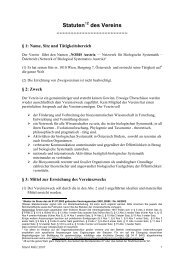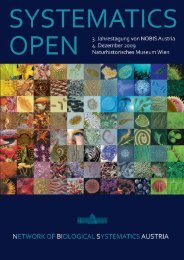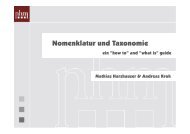4. Jahrestagung von NOBIS Austria 2. - 3. Dezember 2010
4. Jahrestagung von NOBIS Austria 2. - 3. Dezember 2010
4. Jahrestagung von NOBIS Austria 2. - 3. Dezember 2010
Create successful ePaper yourself
Turn your PDF publications into a flip-book with our unique Google optimized e-Paper software.
How and why to achieve more objectivity in taxonomy,<br />
exemplified on a fossil ostracod from long-lived Lake Pannon<br />
Danielopol, D.L. 1 , Gross, M. 2 & Minati, K. 3<br />
1 Österr. Akad. Wiss., c/o Inst. Erdwiss., Geol. & Paläont., K-F-Univ. Graz, Heinrichstr. 26, A 8010<br />
Graz, ddanielo@oeaw.ac.at; 2 Universalmus. Joanneum, Weinzöttlstr. 16, A 8045 Graz,<br />
martin.gross@museum-joanneum.at; 3 Inst. Erdwiss., Geol. & Paläont., K-F-Univ. Graz, Heinrichstr.<br />
26, A 8010 Graz, kmg@gmx.at<br />
Taxonomists are commonly confronted with poor descriptions. The situation is exacerbated for fossil<br />
taxa which display few homologue landmarks useful for defining morphological traits. These latter are<br />
either necessary for building a clear taxonomic diagnosis or for further phylogenetic analysis.<br />
Amplocypris abscissa was briefly described by A. E. Reuss (1850) from several outcrops near Vienna<br />
and Sopron (Vienna Basin; Upper Miocene, Pannonian). Subsequently, it was mentioned all around<br />
the Pannonian Basin respectively the Palaeo-Lake Pannon, which covered this area at that time: from<br />
the western sites in <strong>Austria</strong> and Slovakia, to eastern and southern ones (Romania, Serbia and<br />
Croatia). This geographic distribution contrasts with the high number of fossil species belonging to this<br />
genus, which are considered to be endemic in Lake Pannon. Our project on fossil ostracods from<br />
Hennersdorf (Vienna Basin, Pannonian “D”) document A. abscissa as a polymorphic taxon. Moreover<br />
the genus Amplocypris Zalanyi 1944, displays an elusive diagnosis and an unsecured phylogenetic<br />
position. We demonstrate, using a precise protocol, how the taxonomic status of both of the genus<br />
Amplocypris and of the species A. abscissa can be achieved in an accurate and reproducible way: (a)<br />
A comparative morphological study of the valves, for fossil Amplocypris species and Recent<br />
representatives of genera belonging to higher-rank taxa, using both TL- and SE-microscopy, is<br />
absolutely necessary for developing a clear differential diagnosis of this genus and its allocation to one<br />
of the Cyprididae subfamilies (i.e. the Eucypridinae). (b) Amplocypris displays few homologue<br />
landmarks. Geometric morphometrics for outlines, combined with an original algorithm, which<br />
resemble a semi-landmark approach, offers the possibility to create morphological traits: Linhart’s B-<br />
spline Approach (cf. the web site “Methods in Ostracodology” at http://palstrat.uni-graz.at). (c) Data<br />
expressed as pair-wise resemblance matrix of Euclidean distances are further analysed using<br />
techniques specific to numerical taxonomy, like UPGMA-cluster analysis, Principal coordinate analysis<br />
and the SIMPER exploratory analysis (cf. the computer package PRIMER v6 and PERMANOVA+ for<br />
PRIMER). (d) A matrix of dissimilarity values of the traits, expressed as arithmetic means with their<br />
99% CL, allow to produce a new diagnosis of A. abscissa and to separate it from two other unnamed<br />
taxa. Together they form a phylogenetic lineage.<br />
_____________________________________________________________________________<br />
Ber. Inst. Erdwiss. K.-F.-Univ. Graz, Band 15, <strong>2010</strong>; ISSN 1608-8166 11






